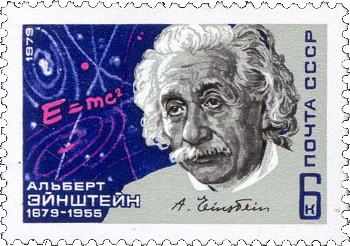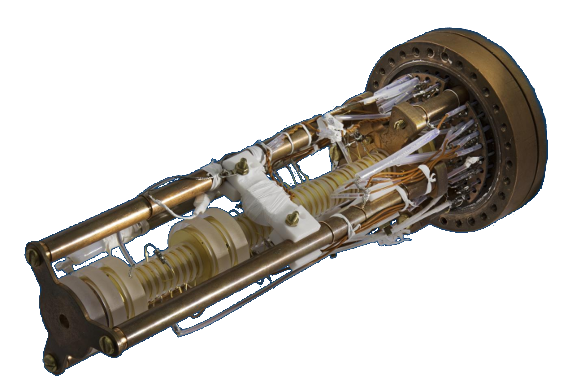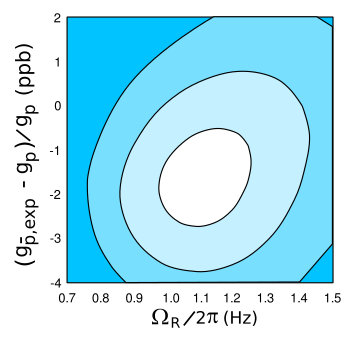Antimatter
January 8, 2018
Antimatter is an important
energy source in the
Star Trek fictional universe. The complete annihilation of
matter and antimatter produces considerable energy, as quantified by the famous
E = mc2 equation. This is considerably greater than the mere
fusion of
hydrogen into
helium, such as happens in our
Sun, which converts just 0.71% of the original
rest mass. Four hydrogen atoms have a mass of 4.03130
AMU, while the mass of a helium atom is 4.00268 AMU.

A 1979 six kopek USSR postage stamp commemorating the 100th anniversary of the birth of Albert Einstein, originator of the E = mc2 equation.
(Wikimedia Commons image)
Antimatter and ordinary matter must be quite different for such a thing to happen. The strange thing is that, aside from such
nuclear fireworks, the
physical properties of matter and antimatter are identical, as
experiments have confirmed to high
precision. This makes all the more
mysterious the fact that anti-matter is nearly absent from our
universe, where just ordinary matter remains.
As I wrote in an
earlier article (CPT Symmetry, October 29, 2015), an experiment at
CERN captured
antiproton and hydrogen
ion pairs to measure the
charge-to-mass ratio of
protons and
antiprotons.[1-2] Measurement of about 6,500 pairs over a 35-day period showed that the charge-to-mass ratio is identical to within just 69
parts per trillion.[1-2]
Experiments with
ALICE (A Large Ion Collider Experiment) at the
Large Hadron Collider (LHC) looked at the masses of
helium-3 nuclei and
deuterium nuclei, along with that of their respective
antiparticles.[3-5] These results showed a close correspondence between the masses of the
deuteron and
antideuteron, with a mass difference that was just 1.7 x 10
-4 GeV/c
2 from the
CODATA deuteron mass of 1.8756 GeV/c
2.[3]
To complement these efforts to find differences in the charge and mass of complementary matter and antimatter particles, a huge international team from CERN,
Japan, and
Germany have measured the antiproton
magnetic moment to the
parts-per-billion level.[6-9] The member institutions of this
BASE (Baryon Antibaryon Symmetry Experiment) collaboration are CERN,
RIKEN (Saitama, Japan), the
Leibniz Universität (Hannover, Germany), the
Max-Planck-Institut für Kernphysik (Heidelberg, Germany), the
University of Tokyo (Tokyo, Japan), the
Johannes Gutenberg-Universität (Mainz, Germany),
Physikalisch-Technische Bundesanstalt (Braunschweig, Germany),
GSI - Helmholtzzentrum für Schwerionenforschung GmbH (Darmstadt, Germany), and the
Helmholtz-Institut Mainz (Mainz, Germany).
The magnetic moment of the antiproton is not well characterized, having been measured previously only at the parts-per-million level.[6] That's because the magnetic moment is very small, 660 times smaller than a
positron's magnetic moment.[6] Of course, to do an experiment with antiprotons, you need to collect a bunch of antiprotons, which is not an easy task. Sixteen antiprotons were stored in a
vacuum reservoir trap at CERN in 2015, and they were analyzed between August and December, 2016, after being stored for 405 days.[8,9] This was the longest documented storage period for antimatter, which is annihilated when it contacts ordinary matter.[8,9]
The precision of this measurement of the magnetic moment of the antiproton actually exceeded that for protons.[7] Says CERN's
Christian Smorra, first
author of the study, "It is probably the first time that
physicists get a more precise measurement for antimatter than for matter, which demonstrates the extraordinary progress accomplished at CERN's Antiproton Decelerator."[7]
This precision was accomplished by doing simultaneous measurements on two antiprotons in two separate
Penning traps, as shown in the figure.[7] These Penning traps use
electrical and
magnetic fields to capture the antiprotons, and they allowed measurement of the
Larmor frequency and the
cyclotron frequency, a combination of which gives the magnetic moment, which is also referenced as the
g-factor.[8,9] The measurement was the equivalent of measuring the
circumference of the Earth to a precision of four
centimeters.[8,9]

The BASE Penning trap system used to measure the magnetic moment of the antiproton. (Image: Stefan Sellner, Fundamental Symmetries Laboratory, RIKEN, Japan, via Johannes Gutenberg Universitaet Mainz.)
The measurement, which has a precision of 1.5 parts-per-billion, gave the magnetic moment of the antiproton as −2.7928473441(42) in units of the
nuclear magneton, where the parenthetical number represent the 68%
confidence interval on the last digits of the value. Compare this with the proton magnetic moment of 2.792847350(9) found by the research team at the Johannes Gutenberg-Universität in 2014.[6-7] The results are consistent with these magnetic moments being equal to the experimental uncertainty.

Statistical evaluation of the results of the proton-antiproton magnetic moment experiment, as plotted as a function of the Rabi frequency (ΩR/(2π).
The 68.3%, 95.5% and 99.7% confidence levels are shown in ascending levels of darker color, respectively, with the darkest area marking points outside those confidence limits.
(Derived from data in ref. 6, drawn using Inscape.)
This is another experimental confirmation of
CPT symmetry, a fundamental
symmetry between particles and antiparticles. Says Smorra,
"All of our observations find a complete symmetry between matter and antimatter, which is why the universe should not actually exist... An asymmetry must exist here somewhere but we simply do not understand where the difference is. What is the source of the symmetry break?"[8,9]
References:
- S. Ulmer, C. Smorra, A. Mooser, K. Franke, H. Nagahama, G. Schneider,T. Higuchi, S. Van Gorp, K. Blaum, Y. Matsuda, W. Quint, J. Walz, and Y. Yamazaki, "High-Precision Comparison of the Antiproton-to-Proton Charge-to-Mass Ratio", Nature, vol. 524, no. 7564 (August 13, 2015), pp. 196-199, doi: 10.1038/nature14861. This is an open access article with a PDF file here.
- Protons and antiprotons appear to be true mirror images, RIKEN Press Release, August 13, 2015.
- ALICE Collaboration, "Precision measurement of the mass difference between light nuclei and anti-nuclei," Nature Physics (August 17, 2015), doi:10.1038/nphys3432. This is an open access article with a PDF file here.
- CERN: Most precise measurement of mass and charge of light nuclei and anti-nuclei, Technical University of Munich Press Release, September 2, 2015.
- Diego Freire, "Experiment confirms fundamental symmetry in nature," São Paulo Research Foundation, September 16, 2015.
- C. Smorra, S. Sellner, M. J. Borchert, J. A. Harrington, T. Higuchi, H. Nagahama, T. Tanaka, A. Mooser, G. Schneider, M. Bohman, K. Blaum, Y. Matsuda, C. Ospelkaus, W. Quint, J. Walz, Y. Yamazaki, and S. Ulmer, "A parts-per-billion measurement of the antiproton magnetic moment," Nature, vol. 550, no. 7676 (October 19, 2017), pp. 371-374, doi:10.1038/nature24048.
- Corinne Pralavorio, "A more precise measurement for antimatter than for matter," CERN Press Release, October 19, 2017.
- Materie-Rätsel bleibt weiter spannend: Fundamentale Eigenschaft von Proton und Antiproton identisch, Johannes Gutenberg University of Mainz Press Release in German, October 19, 2017.
- Riddle of matter remains unsolved: Proton and antiproton share fundamental properties, Johannes Gutenberg University of Mainz Press Release in English, October 18, 2017.
Linked Keywords: Antimatter; energy; Star Trek; fictional universe; matter; mass-energy equivalence; E = mc2; nuclear fusion; hydrogen; helium; Sun; invariant mass; rest mass; atomic mass unit; AMU; Russian ruble; kopek; Soviet Union; USSR; postage stamp; anniversary; Albert Einstein; Wikimedia Commons; nuclear reaction; nuclear; fireworks; physical property; experiment; accuracy and precision; mystery; mysterious; universe; CERN; antiproton; ion<; charge-to-mass ratio; proton; parts-per notation; parts per trillion; ALICE (A Large Ion Collider Experiment); Large Hadron Collider (LHC); helium-3 nucleus; deuterium nucleus; antiparticle; deuteron; antideuteron; Committee on Data for Science and Technology; CODATA; Japan; Germany; magnetic moment; parts-per-billion; BASE; Baryon Antibaryon Symmetry Experiment; RIKEN (Saitama, Japan); Leibniz Universität (Hannover, Germany); Max-Planck-Institut für Kernphysik (Heidelberg, Germany); University of Tokyo (Tokyo, Japan); Johannes Gutenberg-Universität (Mainz, Germany); Physikalisch-Technische Bundesanstalt (Braunschweig, Germany); GSI - Helmholtzzentrum für Schwerionenforschung GmbH (Darmstadt, Germany); Helmholtz-Institut Mainz (Mainz, Germany); positron; vacuum; Christian Smorra; author; physicist; Penning trap; electric field; magnetic field; Larmor frequency; cyclotron frequency; g-factor; circumference of the Earth; centimeter; Fundamental Symmetries Laboratory, RIKEN, Japan; nuclear magneton; confidence interval; statistics; statistical; Rabi frequency; Inscape; CPT symmetry; symmetry.